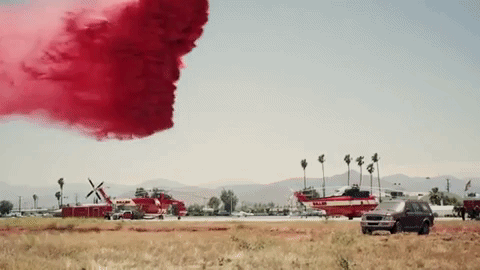A Cool Aerial Firefighting Drop Safety Video Shows The Potential Devastating Effects Of A VLAT (Very Large Air Tanker) Low Drop.
We have almost got used to the breathtaking clips showing large airliners converted in firefighting bombers dropping water or fire retardant to fight wildfires during the fire season in Southern California.
Some of these footages are filmed from drones or helicopters, or simply from distance as the tankers fought wildfires in valleys or mountains. We have posted a few of these in the past years and, generally speaking, you can see the Supertankers (as these aircraft are commonly dubbed) trail a pathfinder aircraft (that are used to point the drop zone for the tanker), nose dive to drop the retardant and then pull-up to perform a sort of “evasive” maneuver to clear the surrouding mountain tops.
Others are shot from the ground, quite close to the fire, and show the same scene from the receiving end of the aerial drop. Well, the following video, posted at the end of August from CAL FIRE (California Department of Forestry and Fire Protection) is aimed at raising the awareness about the risk of working too close to the fire during a low altitude VLAT drop.
“Do you know how much weight is being delivered aerially over the top of you in a wildland fire?”, Cal Fire Battalion Chief Justin Mc Gough asks in the Aerial Firefighting Drop Safety video. Before answering the question, the video goes on to show a low drop performed on a pick-up at Hemet-Ryan Airport, a main Cal Fire Air Attack Base in California, performed by the S-2F3AT Turbo Tracker registered N441DF.
The effect on the drop on the vehicle speaks for itself.
According to the video, the test shown in the footage was carried out with “just” 9,000 pounds (about 4,000 kg) of fire retardant. “Imagine what could happen under a low drop out of a VLAT that can drop up to 170,000 pounds. That’s around the weight of over six type-3 fire engines falling from the sky”.
Control tests conducted by the U.S. Forest Service under optimal conditions have shown that the width of aerial drops can very from 95 feet for LATs and upwards of 130 feet for VLATs. “For safety precaution, we are asking firefighters to stay an additional 50 feet beyond those boundaries,” Seve Flores, USFS Regional Aviation Safety Manager, says in the video.
Drop lengths can vary and must be taken into account too. S-2s and larger tankers have 300 to 1,800 feet of length in line. “When you include VLATs we’re looking at upwards of a mile”, says Captain Fred Mata. Drop heights can vary: from 150 feet above the highest vegetation of a LAT to the minumum shooting at 200 feet of the VLATs. But these are generally guidelines, used for planning the missions: things may change when the aircraft overflies the drop zone with peaks surrounding the plane. The aircraft can drop at lower altitudes because of rising terrain, crosswinds, scarce visibility, malfunctions, etc, resulting in a massive shower of retardant.
By the way, as you may have noticed, the footage also shows a Global SuperTanker Services B747-400 drop as seen from an OV-10 Bronco.
Wow, this whole video has incredible aerial tanker footage. Check out this 747 VLAT drop from an OV-10 Bronco: https://t.co/r4M1PWKFDw pic.twitter.com/nt1qp2hh6e
— Scott Lowe (@tropicostation) November 3, 2019
So, if you see an aircraft (especially a LAT or VLAT) working in the vicinity and you want to snap a video or photo of it dropping the fire retardand on your top, keep in mind that it may be extremely dangerous…
H/T to @tropicostation for posting this!













